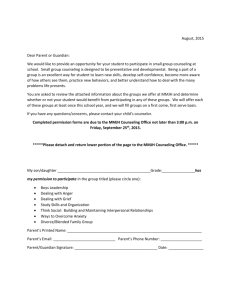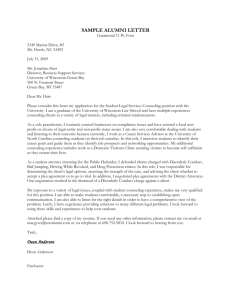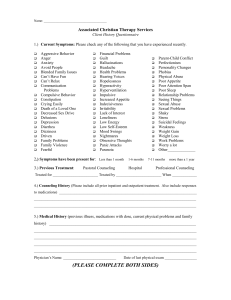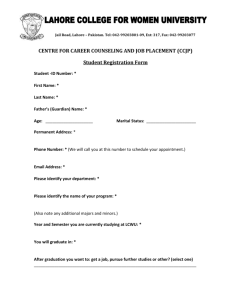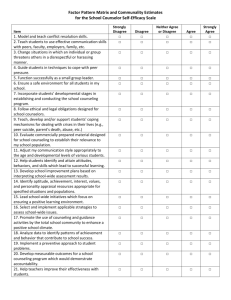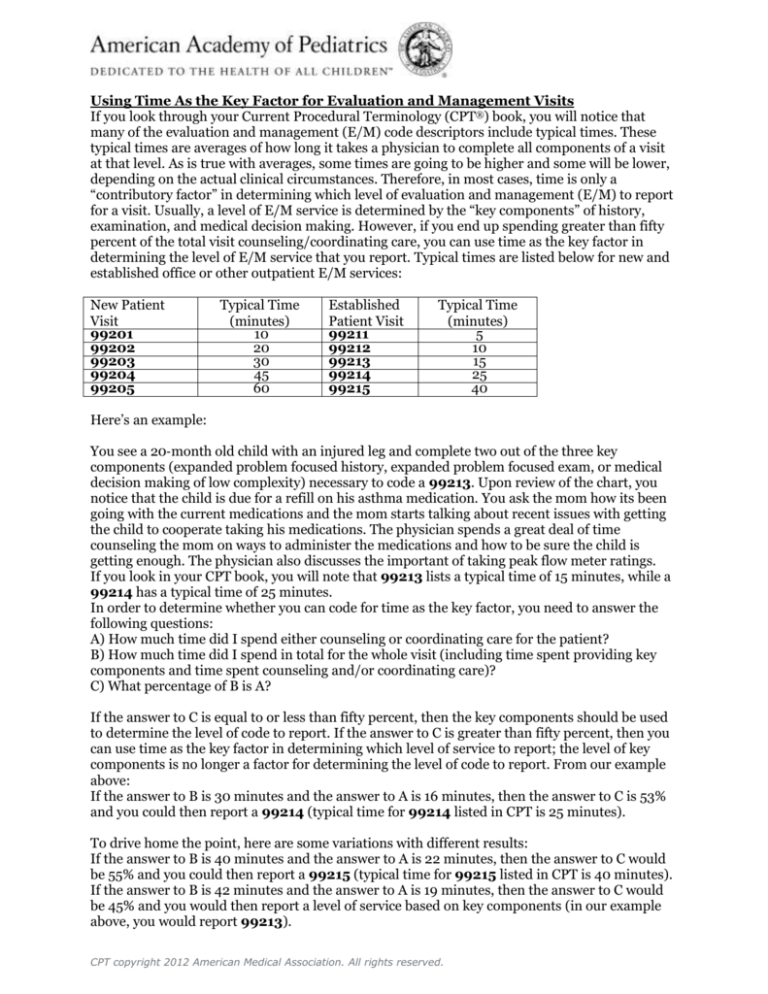
Using Time As the Key Factor for Evaluation and Management Visits
If you look through your Current Procedural Terminology (CPT®) book, you will notice that
many of the evaluation and management (E/M) code descriptors include typical times. These
typical times are averages of how long it takes a physician to complete all components of a visit
at that level. As is true with averages, some times are going to be higher and some will be lower,
depending on the actual clinical circumstances. Therefore, in most cases, time is only a
“contributory factor” in determining which level of evaluation and management (E/M) to report
for a visit. Usually, a level of E/M service is determined by the “key components” of history,
examination, and medical decision making. However, if you end up spending greater than fifty
percent of the total visit counseling/coordinating care, you can use time as the key factor in
determining the level of E/M service that you report. Typical times are listed below for new and
established office or other outpatient E/M services:
New Patient
Visit
99201
99202
99203
99204
99205
Typical Time
(minutes)
10
20
30
45
60
Established
Patient Visit
99211
99212
99213
99214
99215
Typical Time
(minutes)
5
10
15
25
40
Here’s an example:
You see a 20‐month old child with an injured leg and complete two out of the three key
components (expanded problem focused history, expanded problem focused exam, or medical
decision making of low complexity) necessary to code a 99213. Upon review of the chart, you
notice that the child is due for a refill on his asthma medication. You ask the mom how its been
going with the current medications and the mom starts talking about recent issues with getting
the child to cooperate taking his medications. The physician spends a great deal of time
counseling the mom on ways to administer the medications and how to be sure the child is
getting enough. The physician also discusses the important of taking peak flow meter ratings.
If you look in your CPT book, you will note that 99213 lists a typical time of 15 minutes, while a
99214 has a typical time of 25 minutes.
In order to determine whether you can code for time as the key factor, you need to answer the
following questions:
A) How much time did I spend either counseling or coordinating care for the patient?
B) How much time did I spend in total for the whole visit (including time spent providing key
components and time spent counseling and/or coordinating care)?
C) What percentage of B is A?
If the answer to C is equal to or less than fifty percent, then the key components should be used
to determine the level of code to report. If the answer to C is greater than fifty percent, then you
can use time as the key factor in determining which level of service to report; the level of key
components is no longer a factor for determining the level of code to report. From our example
above:
If the answer to B is 30 minutes and the answer to A is 16 minutes, then the answer to C is 53%
and you could then report a 99214 (typical time for 99214 listed in CPT is 25 minutes).
To drive home the point, here are some variations with different results:
If the answer to B is 40 minutes and the answer to A is 22 minutes, then the answer to C would
be 55% and you could then report a 99215 (typical time for 99215 listed in CPT is 40 minutes).
If the answer to B is 42 minutes and the answer to A is 19 minutes, then the answer to C would
be 45% and you would then report a level of service based on key components (in our example
above, you would report 99213).
CPT copyright 2012 American Medical Association. All rights reserved.
NOTE: In every case, it is imperative that you document the extent of the
counseling/coordination of care in the medical record.
QUIZ
Q.
A 7‐year‐old child comes in at the end of the day with his mother and father for follow up of
response to methylphenidate started 3 weeks ago for ADHD. Vital signs, including blood
pressure, height and weight are obtained. You review the results of pre‐ and post‐
Connor Scale questionnaires from the parents and teachers. You question the child and family
regarding appetite, tics, and other potential side effects. Everything seems to be going well and
no further adjustment in medication is made. The child’s mother, who was not present at the
last visit, has multiple questions and concerns regarding such therapy, which you address. What
would normally have been a fifteen‐minute visit has lasted 40 minutes, with 22 minutes of the
total visit being devoted to counseling the patient and his parents.
How would you appropriately bill for this encounter?
A.
99213 Office/outpatient visit, established patient, which requires 2 of 3 key components: an
expanded problem focused history, an expanded problem focused examination, or medical
decision‐making of low complexity. Physicians typically spend 15 minutes face‐to‐face with the
patient and/or family.
This is not the correct answer.
A typical 15‐minute encounter for this type of visit would have likely been coded as a 99213 visit
(office/outpatient visit, established patient) which requires 2 of 3 key components:
an expanded problem focused history,
expanded problem focused examination, or
medical decision making of low complexity
CPT suggests this typically takes about 15 minutes, and would have, if the mother had been there
during the previous visit. As a result of the additional time spent counseling the family, which
was the majority of the total visit time (22 minutes is 55% of 40 minutes), you can bill using time
as the key factor.
B.
99215 Office/outpatient visit, established patient, which requires 2 of 3 key components: a
comprehensive history, a comprehensive examination, or medical decision‐making of high
complexity. Physicians typically spend 40 minutes face‐to‐face with the patient and/or family.
Correct!
Remember that times listed in CPT for E/M services are the typical times it takes a physician to
complete all components of a visit of that level. Some times are going to be higher and some will
be lower, depending on the actual clinical circumstances. Therefore, in most cases, time is only a
“contributing factor” in determining which level of E/M code to report. Usually the “key
components” of history, examination, and medical decision making should be used. However, if
you spend greater fifty percent of the visit counseling and/or coordination care, you can use
time as the key factor. In this case because 40 minutes was spent, you report the 99215 instead
of the 99213. Be certain to document the encounter’s duration in the chart for that
visit including total time spent in counseling/coordination of care.
When Time Spent Falls Between Two Typical Times
If the total time of a visit falls in between two reference codes (eg, a 20 minute visit, which falls
just halfway between a 99213 [15 minutes] and a 99214 [25 minutes]), you need to determine
if the time spent is closer to the lesser time [eg, 15 minutes] or the longer time [eg, 25 minutes].
If the time spent is closer to the lower typical time report the code with the lower time. If the
time spent is closer to the higher typical time, report the code with the higher typical time.
CPT copyright 2012 American Medical Association. All rights reserved.
Example: Physician spends 20 minutes with an established patient and parent. 15 minutes are
spent in counseling/coordination of care. Since 20 minutes falls directly in between a 99213 [15
mins] and 99214 [20 mins], what do you report?
99213 – When the time spent is exactly the mid-point between 2 codes, you round
down.
Example: Physician spends 40 minutes with a new patient. Of that time over 30 minutes is spent
in counseling/coordination of care. Since 30 minutes falls in between a 99203 [30 mins] and a
99204 [45 mins], what do you report?
99204 – Because the typical time mid-point was passed [ie, 38 mins] you can round-up
to the higher code.
Example: Physician spends 30 minutes with an established patient and parent. The entire visit
is spent in counseling/coordination of care. Since 30 minutes falls in between a 99214 [25
mins] and 99215 [40 mins], what do you report?
99214 – Even though you went over the typical time required for code 99214, you did
not pass the mid-point therefore you round down.
Caveat: The above guidelines for reporting when time spent falls between two typical times is a
CPT guideline. Some Medicaid payers may differ.
Caveat: If you perform counseling/coordination of care for greater than 50% of a visit yet the
total visit time does not meet the typical time requirement of even the lowest level code, you
cannot use time as your key factor.
Prolonged Services:
As a result of lengthy counseling/coordination of care encounters, time spent can go beyond
even the highest typical time in the code set. When this happens, you can look to adding
prolonged services. However, when using time as your key factor, prolonged services can only
begin when you have reached a minimum of 30 minutes beyond the typical time listed in the
highest code in the code set (eg, 99205, 99215).
+99354 Prolonged service in the office or other outpatient setting requiring direct patient
contact beyond the usual service; first hour (List separately in addition to code for office or other
outpatient Evaluation and Management service)
+99355
Each additional 30 minutes (Use in conjunction with 99354)
Example: Physician spends 80 minutes with a new patient. Of that time over 60 minutes is
spent in counseling/coordination of care. What do you report?
99205 (60 minutes)
Can you add-on prolonged services? No. Because the time spent was only 20 minutes
above the typical time listed in the highest code (99205 = 60 minutes). You need a
minimum of 90 minutes to add on prolonged services.
Example: Physician spends 80 minutes with an established patient. Of that time over 60
minutes is spent in counseling/coordination of care. What do you report?
99215 (40 minutes)
Can you add-on prolonged services? Yes. Because the time spent was greater than 30
minutes beyond the typical time listed in the highest code (99215 = 40 minutes). You
would then also report 99354 in addition to the 99215 (no modifier is needed).
Be certain to document the encounter’s duration in the chart for that visit
including time spent in counseling/coordination of care.
CPT copyright 2012 American Medical Association. All rights reserved.

